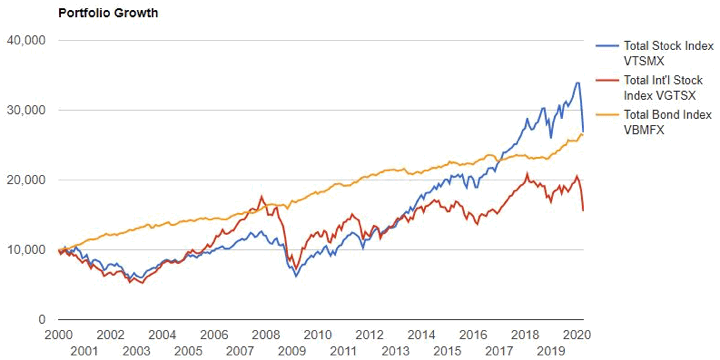If you can take it, here is some more humbling food for thought. Here is a comparison of the growth of $10,000 invested in either the Total US stock, Total International Stock, or Total US bond index fund from the beginning of this century (1/1/2000) until the end of last week. The story is the same if you compare the S&P 500 and the US Aggregate Bond Index total returns. Via Allan Roth and the WSJ article Bonds Are Now Outperforming Stocks in Battle for Returns This Century.

These types of charts will always look rather different depending on the start date chosen. 1/1/2000 happens to be a nice round start date (and also happens to be the year I graduated college). Given the market swings these days, it may look very different again soon.
Still, who could have predicted in January 2000 that bonds would have outperformed US stocks (barely) and International stocks (by a lot) after 20 years? We do the best we can with the historical data that we have, but we should remember how much remains out of our control.
 The Best Credit Card Bonus Offers – 2025
The Best Credit Card Bonus Offers – 2025 Big List of Free Stocks from Brokerage Apps
Big List of Free Stocks from Brokerage Apps Best Interest Rates on Cash - 2025
Best Interest Rates on Cash - 2025 Free Credit Scores x 3 + Free Credit Monitoring
Free Credit Scores x 3 + Free Credit Monitoring Best No Fee 0% APR Balance Transfer Offers
Best No Fee 0% APR Balance Transfer Offers Little-Known Cellular Data Plans That Can Save Big Money
Little-Known Cellular Data Plans That Can Save Big Money How To Haggle Your Cable or Direct TV Bill
How To Haggle Your Cable or Direct TV Bill Big List of Free Consumer Data Reports (Credit, Rent, Work)
Big List of Free Consumer Data Reports (Credit, Rent, Work)
Yeah the starting date makes all the difference. It would look completely different if you start at 2003
Interesting chat, but it’s also good to keep in mind that the run-up in bond returns is driven primarily by decreases in bond yields. Take, for example, the yield on a 20Y treasury: https://fred.stlouisfed.org/series/DGS20
In 2000 the yield on a 20Y treasury was 7%. Today, it’s 1%. When yields fall over time, those holding bonds enjoy price appreciation from their portfolios. Consequently, the last 20 years have been very good to bond holders on that dimension.
Going forward,s bonds will produce anemic returns because investors are eagerly locking in 1% returns for the next 30 years. It’s really unprecedented. There’s practically no upside (in terms of price appreciation) unless one believes that yields could go very negative (like -5%).
Buffett likens a 2% treasury yield as buying a stock with a P/E of 50. I’m willing to bet if we continue this chart 20 years into the future that stock returns will drastically outpace bond returns.
This is really interesting. Robert Kessler is correct. Treasury bonds will always be the best investments. 1% or not the Treasury will be the safety net.
I remember John Bogle once making the point that international investments might increase your diversification but you really should not expect any great enhancement to your returns over time. Looking at this chart seems to confirm that, and I’ve been thinking of trimming my international exposure for some time now. Of course a contrarian view would be that international stocks are poised for a great rebound. It will be interesting to see what the next year or two brings. Strange times indeed.
Large US companies which derive significant revenues from overseas are what I prefer, to actual direct investment info foreign equities, excepting special circumstances where you can pick up a specific equity trading at a deep discount.
Ken, stuck in GA:
Check out Jonathan’s good post on the subject via below link, and especially the LT chart.
https://www.mymoneyblog.com/us-vs-international-stocks-cycles-outperformance.html
Be careful not to be blinded by recency bias.